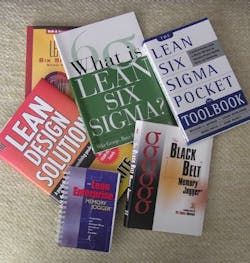Five years ago, it was not uncommon to see “warring camps” within companies that had both Lean Manufacturing and Six Sigma initiatives underway, notes Kevin Simeon, vice president of client services at the George Group, a Dallas-based continuous improvement consulting firm. “They were almost functional silos, with the Lean people not agreeing with and not wanting to talk to the Six Sigma people, and vice versa,” Simeon relates, and with both groups fighting for management attention and resources.
But “tremendous progress” has since been made, says Simeon. Today, many major corporations have successfully integrated Lean—a methodology that focuses on business speed and waste reduction—with Six Sigma—a statistically based process aimed at quality improvement.
Indeed, at a conference chaired by Simeon in Dallas Dec. 1-3, there was plenty of evidence that “Lean Six Sigma” can produce notable operating improvements. The conference, “Discovering the Reality of Lean Six Sigma in Manufacturing, Service and Transactional Environments,” was sponsored by WCBF, a conference producer with U.S. offices in Chicago. Among the presenters were executives from companies including Bank of America, Delphi Steering, Johns Manville, Johnson & Johnson, Lockheed Martin, Medtronic, Northrup Grumman, Pitney-Bowes and Raytheon Missile Systems.
Payoffs
Some speakers reported significant savings through the application of combined Six Sigma and Lean programs. Denver-based Johns Manville Corp., for example, has realized more than $100 million in benefits since beginning a Six Sigma initiative in 2001, said Richard Cunningham, director of operational and business excellence. “We invested about $3 million to get going on this, and we got that back in less than six months,” Cunningham told conference attendees, who numbered around 150.
Likewise, implementation of a Lean Six Sigma program at Lockheed Martin Corp., Bethesda, Md., has enabled a reduction in Atlas missile production cycle times from 48 months to 18 months, said Andrew N. Parris, an Atlas Program Improvement executive. Reducing the number of steps and parts within a process is a lean type of improvement, while Six Sigma involves reducing or eliminating variability, Parris explained. And the company strives to apply both methodologies in a corporate-wide program known as LM21, for Lockheed Martin 21st Century, he said. “We want lean processes operating at Six Sigma capability. That’s what we’re looking for in a process.”
Advice
As the trend toward Lean and Six Sigma integration builds momentum, more companies may find themselves adding tools and capabilities from one discipline to an existing program in the other. And some speakers offered advice on blending the two.
For companies that are deploying Lean in an existing Six Sigma environment, it is important to define Lean as an expansion of the Six Sigma tool set, and not as a replacement, as a way to avoid perceptions of Lean as the newest “program of the month,” said Ginny Moszkowicz, a Six Sigma Black Belt who recently joined Pitney Bowes Inc., Stamford, Conn. Black Belt is the title bestowed upon Six Sigma practitioners who have achieved an advanced certification level in Six Sigma tools and methods. Companies must also decide whether to train their Six Sigma Black Belts in Lean tools, or whether to have separate sets of experts, said Moszkowicz. “Today, fewer and fewer companies are trying to go separate, primarily because you can end up with two fiefdoms competing for projects.”
It is also important to stress to Black Belts in an integrated Lean Six Sigma environment that they are not required to use every single tool at their disposal when solving a problem, Moszkowicz added. “It might be nice to do everything, but in a lot of cases, you don’t need it all,” she said. “And in addition, a lot of the tools are redundant.” A much better approach is to be sure to understand the question or problem to be solved, and then choose a single or limited number of tools that can be used to provide the answer, she noted.
IT savings
While Lean Six Sigma has been applied most broadly in manufacturing to date, one theme of the conference was the growing application of the methodologies in non-manufacturing industries, including financial services and health care. And some speakers pointed out that there are also gains to be made at manufacturing companies by applying Lean Six Sigma disciplines to non-manufacturing functions, such as sales, marketing and information technology (IT).
“Traditionally, in manufacturing, we’ve squeezed, squeezed, squeezed, all the way from the old days of just-in-time manufacturing to the current methods. But if your support functions aren’t getting on board, there’s tremendous opportunity, and this stuff works,” said James R. Serazio, IT Enterprise Process Senior Manager at Raytheon Missile Systems, in Tucson, Ariz. Indeed, said Serazio, the application of Lean Six Sigma to IT operations at Raytheon Missile Systems saved more than $1 million in the first year, rising to more than $13 million by the fourth year in 2003. “And our goal this year is $15 million,” he said.
Information on upcoming WCBF Six Sigma and process improvement-related conferences can be found on the company’s Web site, at www.wcbf.com.
About the Author
Wes Iversen
Managing Editor

Leaders relevant to this article:
